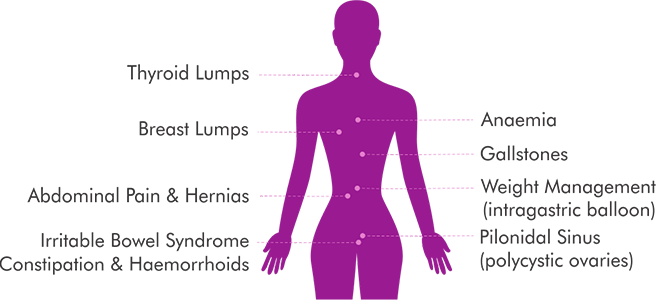

Female Surgical Health
Female Surgical Health and Treatment
There are many health issues that are common to both men and women but affect women differently. The effects of the conditions and symptoms may be similar, but the circumstances and care that is necessary to treat them can differ substantially and in some cases may affect women more severely than men.
Differences in the female anatomy may also result in unique set of health concerns. Below are the most common that are treated by a general surgeon
What are Thyroid Lumps ?
A thyroid lump is an unusual growth of cells that appear on your thyroid gland and are either solid or filled with fluid. They are usually benign (noncancerous) but in rare cases can be malignant (cancerous)
Cause includes:
- Hereditary condition
- Iodine deficiency
- Hashimoto’s disease which is a thyroid condition that causes inflammation and results in large lumps.
Treatments include:
- Surgery – This is done if the lumps are cancerous and if they cause any obstructions with breathing or swallowing.
- Watch and wait (no treatment) – This option is for those that don’t need treatment at that time but are monitored for any changes.
- Radioactive Iodine – This treatment is used for hyperfunctioning thyroid lumps and goiters with several nodules. The thyroid gland absorbs the iodine causing the nodules to shrink.
Thyroid disorders are almost three times more common in women than in men but men have a more aggressive disease and a worse survival rate.
What are Breast Lumps?
A breast lump is a growth of tissue that develops in the breast and feels different to other breast tissue in the same area.
Causes include:
- Breast cancer
- Cysts
- Fibroadenoma – benign lumps
- Lipoma – an overgrowth of fat cells (benign growths)
- Fat Necrosis – scar tissue or a cyst that develops into a lump
- Abscesses – a pus-filled infected lump that grows under the skin
- Intraductal Papilloma – wart like tumour that can develop in the breast duct.
Treatments:
- If cancer is present treatment involves a combination of radiation therapy, chemotherapy, surgery, or hormonal treatment.
- Cysts and fibrous lumps are usually monitored
- An abscess is drained if needed and antibiotics are prescribed
Breast lumps can happen in both men and women for similar reasons. The chance of a lump being cancerous is much lower in men.
What are Abdominal Pain & Hernias?
A hernia occurs when an organ such as the intestine manages to push through an opening in the muscle or tissue, in this case the abdominal wall resulting in pain at the site. A bulge may be felt or seen along the outer side surface of the abdomen, this causes mild pain and aching and/or a pressure sensation. Surgery is often required to prevent further complications, though they aren’t life threatening on their own.
Causes include:
- Muscle weakness and strain
- Aging
- Strenuous activities
- Lifting heavy objects
- Chronic coughing
- Pregnancy
- Constipation – Straining during a bowel movement
- Obesity
Treatments include:
- Surgical repair is the only way to treat a hernia and depends on the size of the hernia and the intensity of the symptoms.
- Watchful waiting – monitoring the hernia for possible problems.
- Over the counter medications that can relieve discomfit
Men are generally known to suffer from groin hernias, these are the most common and are essentially a male problem. Other types of hernias occur in women such as the Femoral and Umbilical hernia, but the symptoms and diagnosis are the same for both men and women.
Irritable Bowel Syndrome?
Irritable bowel syndrome (IBS) is a condition that affects the large intestine causing abdominal pain, cramping, bloating, constipation, diarrhoea, and gas.
Causes include:
- Muscle contractions that last longer in the intestine
- The link between the nervous system and the gut
- Inflammation of the intestine
- Infections
- Change in bacteria
Treatments include:
- Dietary changes – more fibre such as fruits, vegetables, and nuts
- Drink more water
- Avoid caffeine
- Limit cheese and milk intake
- Exercise regularly
- Quit smoking
- Eat smaller meals
Irritable bowel syndrome is more prevalent in women than men as the estrogen and progesterone present interfere and slow down gut mobility.
What is Anaemia?
Anaemia is a condition where there is a low amount of red blood cells to carry enough oxygen to your body. This results in feeling tired, cold and weak and the skin often looks pale in complexion.
Causes include:
- Blood loss
- High rates of red blood cell destruction
- Lack of red blood cell production
Treatments include:
- Iron supplements (taken orally)
- Iron given through an intravenous infusion
- Eating foods rich in iron
- Iron injections
- Transfusions of red blood cells
Iron deficiency is likely to occur in women more due to the onset of periods and pregnancies.
What are Gallstones?
Gallstones are hardened deposits of digestive fluid that form in the gallbladder and range in size from a small grain of sand to a large golf ball. They may not cause any signs or symptoms but if lodged in a duct they cause a blockage and result in sudden and intense pain as well as nausea and vomiting. Risk factors include
Causes include:
- The gallbladder doesn’t empty properly
- Bile contains too much bilirubin -a chemical produced when your body breaks down red blood cells.
- Bile contains too much cholesterol
Treatment includes:
- Medications to dissolve them – this may take months or years of treatments
- Surgery to remove the gallbladder
Women are more likely to develop gallstones than men, this is due to the estrogen present during reproductive years that increases biliary cholesterol secretion. Other risk factors include a family history of gallstones, obesity, and a rapid loss of weight.
Weight Management in women
Weight management is a treatment that is necessary to keep weight at a healthy level. This can reduce the risk of developing serious health conditions and is often used by people who have eating disorders, who need to put on or lose weight or who have a chronic illnesses.
Causes include:
- Medical conditions and disabilities
- Genetics
- Mental ill-health
- Eating disorders
- Drugs/tobacco or alcohol
- Certain medications
Treatments include:
- Healthy eating plans
- Weight-management/weight-loss programs
- Weight-loss medicines/devices
- Managing stress
- Physical activity
- Supplements
It is harder for women to lose weight than men as women have more body fat and less muscle, and this affects the metabolic rate at which calories are shed. Women have the added fat of pregnancy and menopause and find it difficult to lose the extra weight.
What are Pilonidal Sinus?
Pilonidal sinus is an irregular hole or pocket at the top of the buttocks. It is visible to the naked eye and contains hair and skin trapped in the pores of the skin and results in inflammation and infection. Symptoms include swelling, pain fever and redness at the site.
Causes include:
- Large amounts of hair
- Prolonged sitting
- Excessive sweating
- Ingrown hairs
- Obesity
Treatments include:
- Incision and drainage – the wounds are left open to heal
- Incision and drainage – the wounds are closed
- Marsupialisation – after drainage the area is sewed up to form a pouch
- Complete cyst and cyst wall removal
Pilonidal sinus disease occurs in men more than women. It can affect men who are truck drivers and office workers as they sit for long periods of time, and men who have thick or rough body hair (which can be hereditary).
